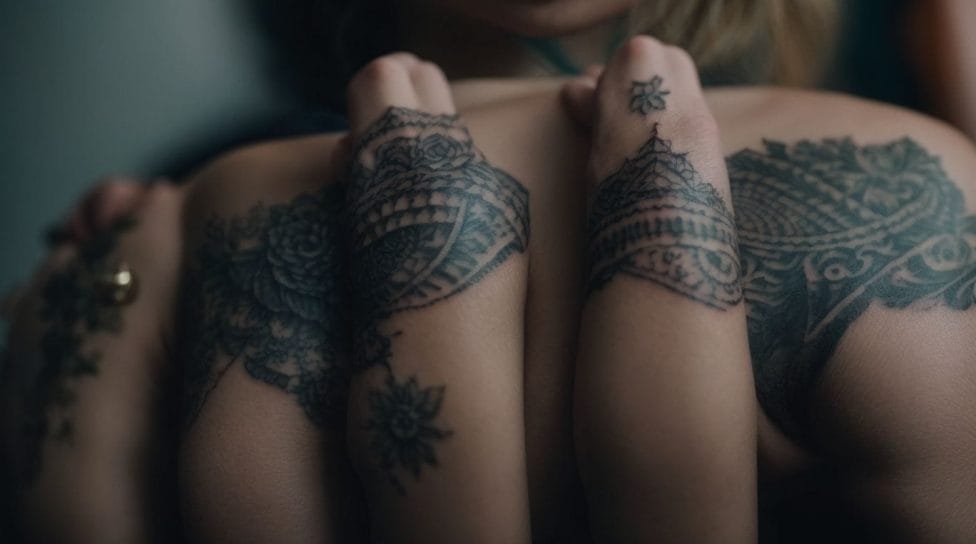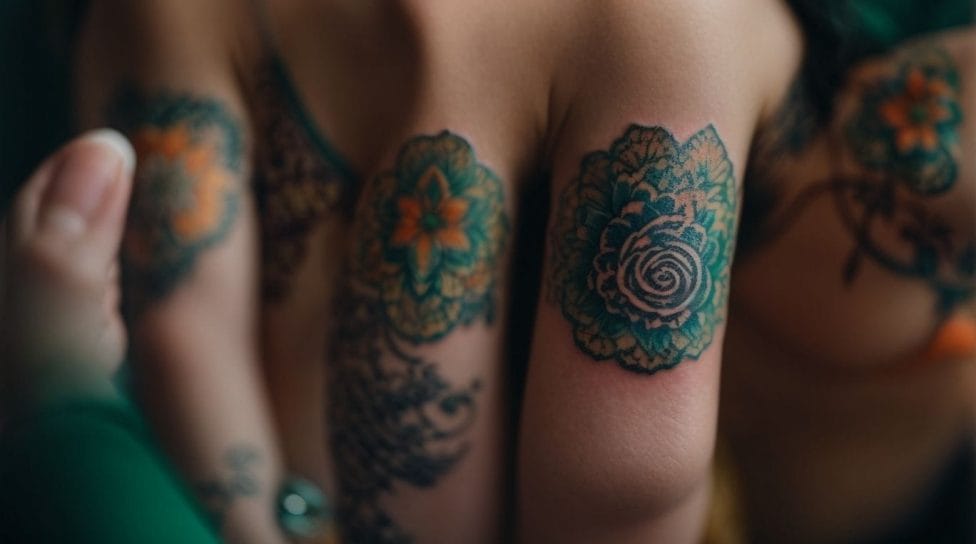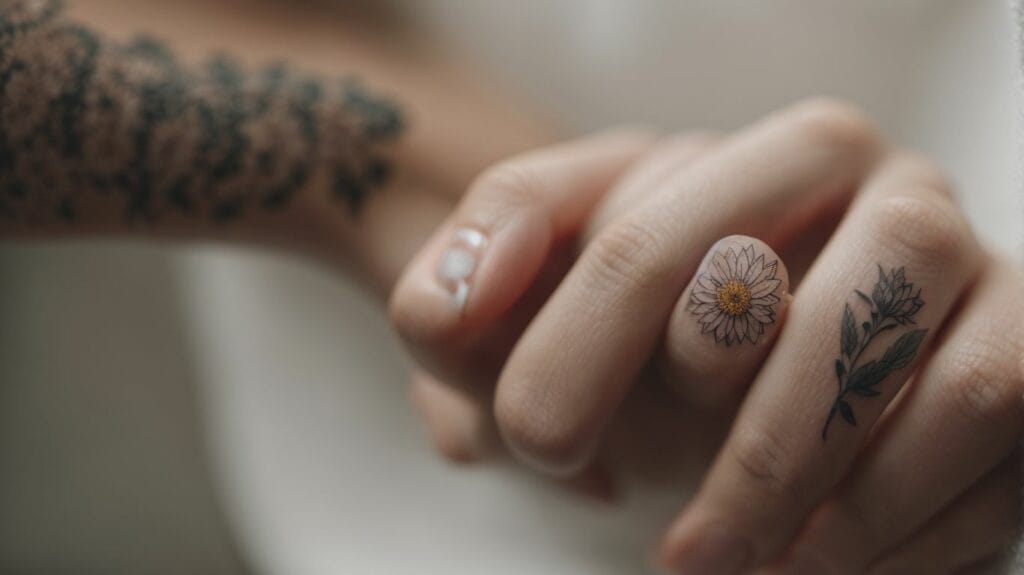Getting a tattoo is a personal choice that comes with various factors to consider, including the level of pain involved. Regarding finger tattoos, pain levels can vary depending on several factors. Understanding these factors can help you make an informed decision. Let’s explore the factors affecting tattoo pain and discuss finger tattoos in detail.
Factors Affecting Tattoo Pain:
1. Location: The location of a tattoo plays a crucial role in its pain level. Areas with thin skin, like the fingers, tend to be more sensitive and may cause more discomfort.
2. Skin Sensitivity: Each individual’s pain tolerance and skin sensitivity vary. Some people may find finger tattoos more painful, while others may not experience as much discomfort.
3. Tattoo Design and Size: The complexity and size of the tattoo design can contribute to the pain level. Intricate designs or larger tattoos may require more time and cause more discomfort.
Do Finger Tattoos Hurt?
Finger tattoos are often regarded as more painful due to the minimal layer of fat and thin skin in that area. The fingers also have an abundance of nerve endings, which can heighten sensitivity during the tattooing process. However, pain levels can still vary between individuals.
Pain Levels for Finger Tattoos:
1. Outer Finger: Tattooing the outer side of the finger generally tends to be less painful than other areas.
2. Inner Finger: The inner side of the finger is typically more sensitive and can cause a moderate level of discomfort during the tattooing process.
3. Knuckle Tattoos: Knuckle tattoos are known to be more painful as the skin is even thinner and the bones are closer to the surface.
Tips to Minimize Pain for Finger Tattoos:
1. Choose a Professional Tattoo Artist: Working with an experienced and skilled tattoo artist with expertise in finger tattoos can reduce the risk of excessive pain and ensure a successful outcome.
2. Numb the Area: Some individuals opt for numbing creams or local anesthetics to minimize pain during the tattooing process. However, it is essential to discuss this option with your tattoo artist and follow their guidance.
3. Breathe and Stay Relaxed: Practicing deep breathing exercises and maintaining a relaxed state of mind can help ease pain and make the tattooing experience more comfortable.
Recovery and Aftercare for Finger Tattoos:
After getting a finger tattoo, proper care is crucial to promote healing and prevent complications. Key aftercare tips include keeping the tattoo area clean and dry, avoiding sun exposure as much as possible, and regularly moisturizing the skin to prevent excessive dryness.
While the pain involved in finger tattoos may be a concern, considering these factors and following proper aftercare instructions can help ensure a positive tattooing experience. Always consult your tattoo artist for personalized advice and guidance based on your needs.
Key takeaways:
- Finger tattoo pain can be influenced by location, skin sensitivity, and tattoo design and size.
- Pain levels for finger tattoos can vary, with outer finger tattoos often less painful than inner finger or knuckle tattoos.
- To minimize pain during finger tattoos, it is important to choose a professional tattoo artist, consider numbing the area, and practice relaxation techniques.
Factors Affecting Tattoo Pain

Photo Credits: Tattooineplanet.Com by Christopher Rivera
Curious about the pain levels of finger tattoos? Let’s dive into the factors that contribute to the tattoo pain experience. From the location of your finger to your skin sensitivity and even the design and size of the tattoo, each aspect plays a role in how much you’ll feel during the inking process. Get ready to uncover the truth behind finger tattoo pain and gain insights to help you make an informed decision for your next ink venture.
1. Location
When it comes to finger tattoos, the location of the tattoo plays a significant role in determining the level of pain experienced. Because the fingers have thinner skin and are closer to the bone, they tend to be more sensitive. As a result, the degree of pain varies depending on which part of the finger is tattooed. In general, outer finger tattoos are less painful than inner finger or knuckle tattoos. To ensure precision and minimize discomfort, it is crucial to select a professional tattoo artist who specializes in finger tattoos. Additionally, proper aftercare, such as keeping the area clean and moisturized, is essential for the healing process.
2. Skin Sensitivity
Skin Sensitivity is a critical aspect to consider when considering a finger tattoo. Some individuals have a higher level of sensitivity in their skin, leading to a more painful experience during the tattooing process. For those who possess this skin sensitivity, finger tattoos may result in increased discomfort compared to tattoos on other areas of the body. It is crucial to seek advice from a professional tattoo artist who can evaluate your skin sensitivity and offer appropriate recommendations. Implementing numbing creams or adopting relaxation techniques can assist in minimizing the pain during the tattooing procedure. In addition, proper aftercare, including maintaining cleanliness and applying moisturizer, plays a vital role in the healing of finger tattoos.
3. Tattoo Design and Size
When it comes to finger tattoos, the design and size of the tattoo play a crucial role in determining the overall experience and pain level. Here are key factors to consider:
- Tattoo Design and Size: Intricate designs with fine details can be more painful due to the required needlework.
- Tattoo Size: Larger tattoos cover a larger area and can result in more discomfort compared to smaller tattoos.
- Placement: Finger tattoos are often exposed to frequent movement, contributing to discomfort during healing.
- Skin Condition: The condition of your skin, including its sensitivity, thickness, and elasticity, can influence the pain experienced.
- Individual Pain Threshold: Each person’s pain tolerance varies, so what may be painful for one person may not be for another.
Considering these factors, including the design and size of the tattoo, can help you make an informed decision and ensure a more comfortable tattooing experience.
Do Finger Tattoos Hurt?

Photo Credits: Tattooineplanet.Com by Zachary King
Do Finger Tattoos Hurt?
Getting a tattoo on your finger can be more painful than getting one on other body parts. The skin on your fingers is thinner and has less fat and muscle, making it more pain-sensitive. The bones and tendons in your fingers are closer to the surface, which can intensify the discomfort. While pain tolerance varies from person to person, it’s generally agreed upon that finger tattoos can be more painful. So, if you’re considering a finger tattoo, be prepared for discomfort.
Pain Levels for Finger Tattoos

Photo Credits: Tattooineplanet.Com by William Thompson
Curious about getting a finger tattoo? Let’s dive into the pain levels associated with different areas of the finger: outer finger, inner finger, and knuckles. We’ll explore the sensations experienced by tattoo enthusiasts in each of these areas, sharing insights backed by real experiences. Brace yourself for some surprising facts and figures to help you make an informed decision before getting inked in one of these finger locations.
1. Outer Finger
The outer finger, where people often choose to get tattoos, is a favored location due to its visibility and easy access to tattooing. The pain level experienced can vary depending on individual pain tolerance and the intricacy of the design. In general, tattoos on the outer finger are considered more painful compared to other parts of the finger. This greater discomfort is attributed to the thinner skin and fewer nerve endings in this area. To minimize pain, it is advisable to select a professional tattoo artist, consider numbing the outer finger, and remain relaxed during the tattooing process. Proper aftercare, including keeping the outer finger clean and moisturized, is also crucial for facilitating proper healing.
2. Inner Finger
Tattooing the inner finger can be a painful experience due to the thin skin and numerous nerve endings in the area. Pain tolerance varies from person to person.
- Location: The inner finger is a sensitive spot for tattoos due to the lack of muscle and fat padding.
- Tattoo Design and Size: Intricate and larger designs can cause more pain as they require longer tattooing sessions.
- Pain Levels: The pain can range from mild discomfort to intense sensations, with some individuals experiencing sharp and stinging sensations.
3. Knuckle Tattoos
Knuckle tattoos, also known as finger tattoos, are a popular choice among tattoo enthusiasts. However, it’s important to note that they can be more painful due to the lack of padding and their proximity to bone and nerves. If you’re considering getting a knuckle tattoo, here are some key points to keep in mind:
- Greater pain: One factor that sets knuckle tattoos apart is the fact that the skin on the knuckles is thinner and more sensitive, which makes the tattooing process more painful.
- Challenging design: Another aspect to consider is the limited space and curved surface of the knuckles, which can pose challenges for intricate designs. To ensure a successful outcome, it’s recommended to opt for simple and bold designs.
- Fading and blurring: Knuckle tattoos have a higher likelihood of fading and blurring over time. This is mainly due to the frequent movement and exposure to friction that the hands experience daily.
- Professional artist: To achieve the best results and minimize pain, it’s crucial to work with an experienced tattoo artist who specializes in finger and knuckle tattoos. They can ensure precise placement and provide expert guidance throughout the process.
- Adequate aftercare: Proper aftercare is essential for maintaining the appearance of your knuckle tattoo. Be sure to follow the instructions, keeping the area clean and moisturized. Avoiding direct sunlight is also important to prevent fading. Additionally, touch-ups may be required to keep your tattoo looking its best.
Tips to Minimize Pain for Finger Tattoos

Photo Credits: Tattooineplanet.Com by Ryan White
Are you looking to get a tattoo on your fingers but worried about the pain? Don’t fret! We’ve got some fantastic tips to minimize the discomfort during the process. From choosing a skilled tattoo artist to numbing the area and maintaining a relaxed mind, we’ll cover it all. So, if you’re ready to ink your fingers with style and minimum pain, keep reading!
1. Choose a Professional Tattoo Artist
When it comes to getting a finger tattoo, it is essential to choose a professional tattoo artist. There are several reasons why this is important:
- Experience and skill: Professional tattoo artists have the necessary expertise to create intricate designs and overcome the challenges of tattooing on a small and delicate area, such as the finger.
- Safety and hygiene: Professionals adhere to strict hygiene practices, ensuring a clean and sterile environment to minimize the risk of infections.
- Artistic style: Tattoo artists have unique styles, so it is crucial to select someone who specializes in the type of design you desire. This ensures the best possible outcome.
- Professional equipment: Reputable artists use high-quality equipment and ink, which leads to better results and reduces the chance of complications.
It is a fact that finger tattoos require more frequent touch-ups due to constant movement and exposure to friction, leading to faster fading.
2. Numb the Area
Numbing the area before getting a finger tattoo is a helpful method to minimize the pain and discomfort. Below are some effective steps to numb the area:
1. Apply a topical numbing cream: Before your tattoo appointment, use a numbing cream that contains lidocaine or benzocaine on the area. This cream will numb the skin and reduce pain sensations.
2. Utilize ice or cold packs: Before and during the tattooing process, place an ice pack or a cold compress on the tattooed area. The cold temperature will numb the skin and make it less pain-sensitive.
3. Consider nerve-blocking injections: In certain situations, a professional tattoo artist or a healthcare provider may administer a local anesthetic injection. This injection will block the nerves responsible for pain sensation, providing temporary numbness.
Remember to consult with a professional tattoo artist or a healthcare provider before employing numbing methods to ensure their safety and suitability for your specific situation.
3. Breathe and Stay Relaxed
- Before getting the tattoo, remember to breathe deeply and stay relaxed to calm your nerves.
- Throughout the tattooing process, make a conscious effort to focus on your breathing and relax your muscles.
- Take slow, deep breaths through your nose and out through your mouth to maintain a steady breathing pattern.
- To distract yourself, clear your mind and think of something enjoyable while getting the tattoo.
- If the pain starts to feel overwhelming, make use of breaks and continue with your deep breathing exercises.
Remember, incorporating deep breathing and staying relaxed can help minimize the pain and discomfort associated with getting a finger tattoo. It’s important to remember that pain tolerance varies from person to person so results may differ.
Recovery and Aftercare for Finger Tattoos

Photo Credits: Tattooineplanet.Com by Jack Torres
When it comes to finger tattoos, proper recovery and aftercare are crucial. So, how do you ensure your finger tattoo heals perfectly? In this section, we’ll dive into essential tips for a successful recovery. From keeping the area clean and dry to avoiding sun exposure and regular moisturizing, we’ve got you covered. So, let’s explore these effective practices to ensure your finger tattoo heals beautifully and stands the test of time.
1. Keep the Area Clean and Dry
Maintaining cleanliness and dryness is crucial for proper healing and preventing infection regarding finger tattoos. Here are some steps to ensure that you keep the area clean and dry:
- Begin by washing your hands thoroughly with soap and water before touching or cleaning the tattooed area.
- Next, use a mild, fragrance-free soap and lukewarm water to cleanse the tattoo gently. Remember to avoid scrubbing the area.
- After cleaning, gently pat the tattooed area dry with a clean, soft towel. It’s important to avoid rubbing or scratching the tattoo.
- Throughout the healing process, make sure to keep the tattooed area dry. Avoid activities that may cause excessive sweating or exposure to water.
- To prevent irritation and promote airflow, it’s advisable to wear loose-fitting clothing and avoid tight garments that may rub against the tattooed area.
- Lastly, protect the tattoo from direct sunlight and tanning beds, as they can fade the tattoo and slow the healing process.
2. Avoid Sun Exposure
To protect your finger tattoo from fading or getting damaged, it’s important to avoid sun exposure. Sunlight contains harmful UV rays that can cause the ink to fade and the skin to age prematurely. To prevent this from happening, it is highly recommended that you keep your finger tattoos covered with clothing or sunscreen that has a high SPF. This will serve as a shield, protecting the tattoo from the sun’s rays and ensuring it maintains its vibrancy. Always remember that proper aftercare, including avoiding sun exposure, is crucial for preserving the longevity and appearance of your finger tattoo.
True history: Throughout ancient history, various cultures have recognized the sun as a symbol of power, warmth, and life. The ancient Egyptian, Aztec, and Native American civilizations, in particular, worshipped and revered the sun, often incorporating it into their art and religious practices. The sun was regarded as a source of light and energy, and its significance was evident in their day-to-day lives. Even today, sun exposure remains a significant concern regarding tattoo care as we endeavor to safeguard our body art from the detrimental effects of the sun’s rays.
3. Moisturize Regularly
Moisturizing regularly is crucial for proper healing and maintenance of finger tattoos.
- Hydration: Ensure you moisturize regularly to maintain and heal your finger tattoos effectively. Apply a good quality tattoo-specific moisturizer daily to prevent dryness and cracking.
- Gentle Care: For gentle care, it is important to use a fragrance-free and hypoallergenic moisturizer. This will help avoid any irritation that may occur.
- Protection: To protect your finger tattoo from excessive moisture or dirt, it is recommended to cover it with a breathable bandage when engaging in activities that may expose it to such elements.
Moisturizing regularly not only helps retain the tattoo’s vibrancy but also prevents scabbing and fading. Remember, consistency is key in keeping your finger tattoos looking their best.
Facts About Do Tattoos on Fingers Hurt?
- ✅ Finger tattoos can be more painful compared to tattoos on other parts of the body due to the lack of fat and muscle in that area. (Source: Code of Conduct Tattoo)
- ✅ Simple designs are recommended for finger tattoos, as intricate designs may become blurry over time. (Source: Code of Conduct Tattoo)
- ✅ Blowout is a risk with finger tattoos, which can cause the ink to spread and make the tattoo look fuzzy. (Source: Code of Conduct Tattoo)
- ✅ Fallout can occur with finger tattoos, where the skin rejects pigment, and details of the tattoo may disappear. (Source: Code of Conduct Tattoo)
- ✅ Touch-ups may be necessary for finger tattoos, which can be expensive as you have to pay for the same tattoo twice. (Source: Code of Conduct Tattoo)


